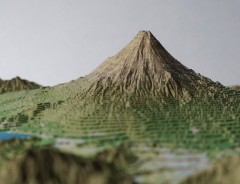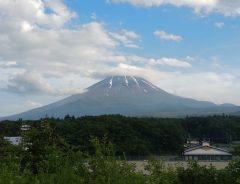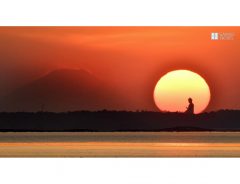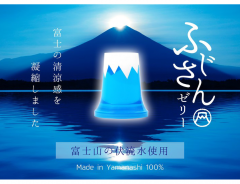
The fujizuka behind Narukotenjinsha shrine in West Shinjuku. | Photo by George Lloyd
Tracing the remains of the ancient Fujikō cult in Tokyo’s mini Mount Fujis
- Tags:
- cult / Fujikō / Fujizuka / Mount Fuji
Related Article
-

Create Models Of Realistic Japanese Mountains – All This Detail And You Can DIY!
-

Doing a circuit of Mt. Fuji by car
-

Adidas team up with Japanese tattoo artist on awesome Mount Fuji and fireworks sneaker design
-

Time-Lapse Video of Giant Buddha Against The Backdrop of The Setting Sun Is Awe-Inspiring
-

Mount Fuji Jelly From Yamanashi Offers a Taste of Japan’s Most Famous Mountain
-

Asahi’s Fujisan beer made with Mount Fuji rice might be the most Japanese ale on the market


Mount Fuji has always been regarded as a sacred mountain, but for much of their history, the Japanese have been content to admire the iconic peak from afar. The only people interested in actually climbing it were the mountain-loving followers of Shugendō, (修験道 'the way of self-discipline'), a sect of mountain ascetics.
However, in the early years of the Edo period (1603–1868), a cult called Fujikō (富士講) arose around the mountain. It was founded by a Shinto priest called Hasegawa Kakugyō (1541–1646), and it turned the ascent of Mount Fuji into a religious rite and duty.
A stone way marker at the foot of the fujizuka in the grounds of Fuji Shrine in Komagome. | Photo by George Lloyd
The followers of the new cult solicited funds from their neighbours in Edo (now Tokyo) to sponsor their annual pilgrimages to Mt. Fuji. Only groups of hardy young men made the trip, for it was not easy to travel from Edo to Mt. Fuji in those days. Children and the elderly found the trek too arduous, and women were forbidden to climb the sacred peak, in the belief that their 'earthiness' would defile its 'purity'.
In 1780, Takada Tōshirō, the leader of a local branch of the Fujikō cult, had the bright idea of building a miniature replica of the sacred mountain on the grounds of his local Shinto shrine. This gave cult followers who were unable, whether through age, infirmity or gender, to climb Mt. Fuji the option of climbing a mini version of the mountain instead.
This was Edo's first fujizuka (富士塚 'mound made in the image of Mt. Fuji'). It jutted 10 metres into the sky and is said to have taken Tanaka and his brethren over nine years to complete. They built it using rust-coloured volcanic rocks painstakingly hauled to the capital from Mt. Fuji. Affectionately known as the Takada Fuji, you can still see it today, tucked away in the grounds of Mizuinari Shrine, near Waseda University.
A reverse shot of the fujizuka behind Narukotenjinsha shrine in West Shinjuku. | Photo by George Lloyd
Thanks to the proselytising of another Shinto priest, Jikigyō Miroku, the Fujikō cult gradually took root among the people of Edo. Wherever the cult went, fujizuka followed. The mini-mountains allowed cult followers of all ages and both sexes to worship the sacred mountain without leaving their neighbourhoods.
Of course, a pilgrimage to the real Mt. Fuji was the ideal, but as the Fujikō cult grew in popularity, it became impractical for all of its adherents to make the trip and this spurred the creation of even more mini replicas. By the time the cult reached the height of its popularity in the early 19th century, there were 800 fujizuka in the city.
The view from the top of the fujizuka in the grounds of Fuji Shrine in Komagome. | Photo by George Lloyd
The cult's followers had a typically pragmatic attitude to religion, and saw no contradiction between their adherence to Shintoism, Buddhism and their worship of Mt. Fuji. Indeed, Fujikō seems to have been a way of cementing social ties as much as of worshipping the sacred mountain, for most branches were organised by and for workmates.
Most fujizuka followed the template of the Takada Fuji in Waseda, albeit on a smaller scale, usually being around ten feet high. So as to cut down on the labour required, they were usually built from local rocks, with genuine Mt. Fuji volcanic stones only being used as a covering. Once the mound was complete, it was adorned with copies of the station markers, shrines and stone monuments found at the 10 waystations on Mt. Fuji itself.
Colourful abstract motifs were a prominent feature of the Fujikō cult. | Photo by George Lloyd
The Fujikō cult continued to thrive well into the Meiji period (1868-1912). According to Mr. Suzuki, the priest at Shinagawa shrine, the fujizuka in the grounds of his shrine was not built until 1869–72. Over the course of the 20th century, however, most of Tokyo's fujizuka were demolished to make way for modern roads and buildings. Thankfully, about 60 of them have survived to the present-day, and most of them can still be climbed.
The best-known examples are in the grounds of Ekoda, Jūjō, Otowa, Takamatsu, Sendagaya, Shinagawa and Shitaya-Sakamoto shrines. The last of these, the Shitaya-sakamoto fujizuka, is in the grounds of Onoterusaki, a popular shrine in the Shitaya/Iriya area. Unfortunately, it is closed to the public for most of the year, but the head priest allows people to scale it on several days each year to celebrate the start of the official climbing season on Mt. Fuji.
Sadly, many of the surviving fujizuka have been reduced in size by unscrupulous builders on the unit for rubble for the foundations of new buildings.
The fujizuka behind Hakusan Shrine in Bunkyo-ku is a shadow of its former self. | Photo by George Lloyd
The mini-Fuji that remains closest to its original shape is probably Toshima Nagasaki, which stands in the grounds of Takamatsu Sengen Shrine in Toshima-ku. It is eight metres high, 21 metres in diameter and covered with volcanic rock hewn from the slopes of Mount Fuji. Its 50 Buddhist statues and religious symbols give some indication of how popular the Fujikō cult used to be in this part of Tokyo.
Another famous fujizuka is the Komagome Fuji close to Rikugien Gardens. It was built atop a prehistoric burial mound and is thought to have been consecrated as a Shinto shrine in 1629.
The best fujizuka I have seen is the one behind Narukotenjinsha shrine in West Shinjuku. It was built in 1920, making it the last to be built in this part of the city. At 12 metres, it is one of the highest in Tokyo, though these days it is dwarfed by the skyscrapers that surround it.
The Fujikō cult was mainly confined to Edo, but there are a few Fuji replicas outside Tokyo as well, such as the Kizoro Fuji in Kawaguchi, Saitama prefecture. Built in 1800, it ranks as one of the oldest fujizuka in Japan. There's even one in the grounds of Fanhams Hall, a hotel in Hertfordshire in the United Kingdom.